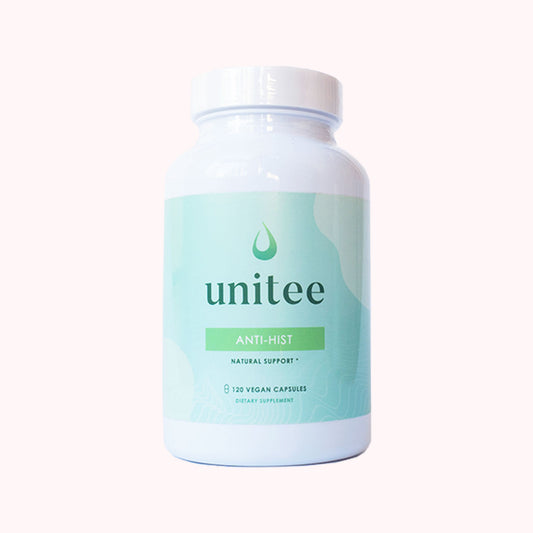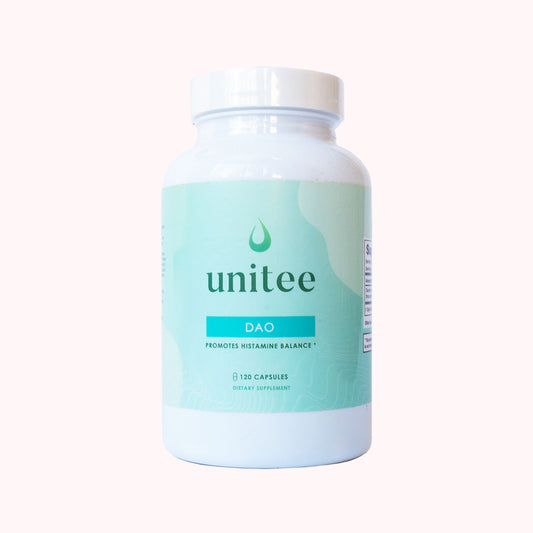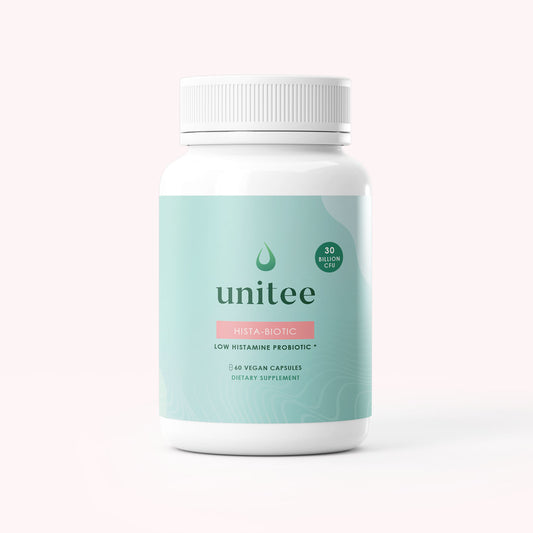If you’re a meal prep junkie, you’re likely making a few common mistakes that could seriously be damaging the nutritional content of your food.
Not only that, but it could be the reason your symptoms of histamine intolerance continue to flare, causing you to suffer from chronic itching, runny nose, diarrhea and other digestive complaints.
Today, you're going to discover why being prepared may not be the best thing for you if you're living with histamine intolerance.
But, I’m going to tell you how to make the most of your meal prep, and prevent histamine from bothering you while you do it!
Can Meal Prepping Impact Histamine Levels?
We all know why we meal prep – we’re busy, we’re rushed, we’re tired, we have food intolerances that make it essential for us to plan. If you don't you'll inevitable end up stressed, hungry and scarfing down something out of pure starvation and easy access ... but of course it's something you know is going to significantly aggravates your symptoms and leave you in agony for hours.
It's no secret that stress and the symptoms of histamine are linked, and chronic stress is definitely not good for our health overall. So, instead of putting yourself in such a position, it's obvious why you prepare yourself a homemade meal and pack it away to get you through the day.
But has it ever occurred to you that Friday’s chicken, rice and veg may actually be nutritionally different and contain significantly higher histamine levels that when you ate it on Sunday?
Food just doesn’t keep its nutritional contents for that long and, unfortunately, it means that by the end of the week your food might not be as nutritious as it once was. Another consideration to factor in, especially when you're living with histamine intolerance, is that the nutritional content of your leftover food will also strongly depend on your meal prep routine.
Where this comes into additional importance for those of you with histamine intolerance, is that histamine levels can actually go haywire and make the same histamine-safe meal actually flare up your symptoms. It's one of the reasons identifying foods that make you flare can be so difficult; no symptoms one day, and all of the symptoms the next, and you've eaten the same food!
Additionally, nutrient deficiencies in histamine intolerance are common, so we want to avoid these as much as possible!
So, what do you do?
The first step, of course, is eating a low histamine diet!
But, knowing how to eat, and really that translates into how to prep your food, is of the utmost importance.
To get a free guide on what to eat and how to optimize your diet for histamine intolerance, click below.
And before I get into the tips and tricks, I'd like you to understand a little more about why your food is no longer as nutritious, and why histamine ramps up in the meal the longer its left over...
Leftovers: Why Nutrients Reduce and Histamine Increases

I’m sure you’re all wondering: how could the exact same meal be both less nutritious and higher in histamine when it contains the same ingredients. What happened to those nutrients, and where did that histamine come from?
The obvious way to think about this is to consider the processes involved in food spoilage. What happens when you forget about that container of food, hidden in the back of the fridge? After weeks or months, you find it and what do you see? It's liquid, stinky, different colours, and likely has some nasty things growing on it. There's no way you'd eat that, would you? And you'd get seriously sick if you did... so into the garbage it does!
Of course, this type of spoilage doesn’t happen overnight. But it certainly starts in a much slower fashion in the short term, where there’s actually a significant number of reactions occurring even in a number of hours following food being cooked that leads to nutrient loss and histamine formation.
Let’s take a look at what’s going on:
Food Oxidation
Oxidation is a reaction that occurs when oxygen comes into contact with food. The oxygen causes chemical reactions to take place that lead to the food breaking down. Oxidation is often responsible for producing funky odors, flavours and colors (1).
Think of a sliced apple that turns brown – this is oxidation! Unfortunately, when foods oxidize, certain nutrients can lose their activity. And while exposure to oxygen and oxidation for a short time doesn’t necessarily mean the food is unsafe for consumption, there is research to suggest when there's a longer period of oxidation, food may become more inflammatory and lead to digestive upset even when the food doesn't look spoilt (2). In any case, it does mean that you may have lost a lot of the goodness that made your meal nutritious in the first place.

Leftover Foods Make Histamine
Histamines are compounds most well-known for their involvement in inflammatory reactions.
Think of someone you know who takes antihistamines to control their symptoms of seasonal allergies. These medications control the itchy eyes, runny nose and hives someone experiences when they come into contact with pollen.
Histamine is often thought of as having a simply role in a reaction to allergens, but what most people don’t realize, is histamine also plays a role in several other disorders. Disorders such as eczema, IBS, SIBO, urticaria, and even fibromyalgia have been shown to have a significant relation to histamine, and people who suffer from these conditions are more likely to display sensitivities to exposure to additional histamine, like you would when eating certain foods.
Now, even though there are certain fresh foods that contain histamine or that liberate histamine in the body, studies have shown that even histamine neutral foods - those that don't naturally contribute to increased histamine in the body - have shown histamine content to increase over time (3,4). And it could be the reason some individuals may feel absolutely fine after consuming leftovers or develope symptomatic inflammatory and allergic-like reactions after eating them.
Microbial Growths May Contribute to Dysbiosis and Higher Histamine
Bacteria and fungi love food.
Just as it does for us, food provides these microbes with nutritional requirements necessary for their growth and proliferation (5,6,7).
Not only can these microbes be toxic to us, even the non-toxic onces can participate in reactions that produce compounds which are unsafe for consumption. These compounds can begin developing in the food long before we can visibly notice and, if consumed, could contribute to a negative impact on your digestive processes by increasing your toxic load and causing unwanted inflammatory processes to occur. Additionally, exposure to some of these microbes may mess with the body's natural microbial balance, further contributing to unwanted symptoms.
There's also the factor of histamine to consider when talking about bacteria and microbes in food.
Bacteria will convert the amino acid histidine into histamine (8). This conversion can take place within the body, but bacteria living outside of the body can also perform this action. That means, any leftover foods may therefore contain higher levels of histamine, and when consumed, contribute to your overall histamine load.
On top of the histamine you're eating, you're also adding more histamine producing bacteria to your system, which is yet another detrimental act if you're histamine intolerant.
On that note, it's also important to use the right probiotics in your supplement routine if you're trying to improve your gut health. Some of these bacteria are natural histamine producers, so you want to avoid compounding your symptoms even further. Most of the probiotics you'll find contain histamine strains, so it's important to check that you're only using low histamine probiotic strains.

Nutrient degradation
Nutrient degradation occurs over time, and is influenced by various factors, notably the time and temperature of storage. Several studies have shown when there is heat involved in storage methods, it significantly influences the nutrient contents of the food, including changing the amount of phytonutrients such as flavonoids and carotenoids, as well as vitamins and minerals available in those foods (9,10,11).
Luckily, storing food in the fridge or freezer and at an appropriate temperature is one of the simplest factors for you to control, as is making sure you're not leaving the food stored for too long to allow the nutrients to breakdown and histamine levels to rise.
Now, even though there are ways to prevent food from breaking down too quickly, these processes mentioned above occur naturally, and so are not easy to completely stop. There are, however, a few easy things you can do at home to slow down and minimize the negative impacts they may have on your food - and your symptoms of histamine intolerance.
5 Steps to Reduce Histamine in Leftover Foods
In a perfect world, I would of course tell you the solution is to go pick fresh, low-histamine fruits and vegetables from your garden and make a home-grown meal while cooking fresh-caught fish from the river... but let’s get real.
You’re busy, so I’m not going to completely take your meal prepping ways away from you.
What you can and should be doing, however, is using a few simple meal prep techniques to retain the nutrient content and reduce the oxidation reactions, as well as the probability of unknowingly exposing yourself to harmful compounds. These simple tips will allow you to optimize the balance between juggling your jam-packed life, minimizing your kitchen commitments, and maximizing your overall health and wellbeing.
1) Freeze meals to reduce histamine levels
One of the best ways to cut corners while maximizing nutritional preservation is by preparing chopped, ready-to-cook raw meals and freezing them. Once you arrive home, throw your bagged and frozen stir-fry in a pan, and by the time you’ve had a chance to change your clothes and wind down, dinner’s already ready. This technique is enough to prevent microbial growth, oxidation and steep histamine increases, all while retaining way more nutrients than cooked and stored food.
Just be sure the food you are freezing is frozen from fresh - this technique will not work if you're freezing already aged food.
2) Use High Quality Air-Tight Storage Containers to Preserve Nutrients and Blunt Histamine Increases
Investing in sturdy, air-tight containers can help to prevent oxidation and microbial growth, as well as maintain the appearance and taste of your meal, protect its nutritional value and blunt any histamine spikes. Additionally, it’s important to consider that common food storage supplies, especially plastics and cling films, actually contain chemicals that can get absorbed by the foods you’re eating. This exposure can increase your risk of developing inflammation and triggering more histamine release in the body.
Investing in high quality containers, which are free of soluble chemicals such as glass containers with an airlock, therefore also contributes to a strategy for reducing your body’s toxic load.
3) Keep Temperature Stable During Transport to Minimize Histamine Levels
As discussed above, temperature storage has a significant impact on nutrient degradation. Keeping your meals stored at a consistent temperature during transport, especially if you have a long commute, can significantly preserve nutrient content.
Easy ways to minimize transport stressors include investing in a small cooler bag or thermal lunch box, which will keep the temperature of your food stable to minimize histamine production and preserve nutrient content.
4) Reheat Food the Right Way to Preserve Nutrients and Maximize Health Benefits
It’s widely known that heating food destroys certain nutrients (12,13,14) – and doing it multiple times at high temperatures can destroy even more of those precious compounds.
Try to refrain from reheating your food on multiple occasions so, where necessary, reheat your meal only once and don't allow the food to get too hot. You can even consider keeping the vegetables raw, only adding them in when you're reheating the other ingredients. By doing this, you're only heating those precious veggies for the first time when you consume the meal, decreasing those thermal stressors and optimizing nutrient preservation.
5) Focus on Low Histamine Foods and Preparation Methods
Over and above these other strategies, it's important to ensure the foods you are eating are low in histamine themselves (15). Additionally, your can also focus on including foods that contain natural antihistamine properties. These types of food can help your body to keep histamine levels as low as possible as a means to reduce symptoms of histamine intolerance and allow your body the break it needs to begin healing.
If you haven't already taken advantage, I urge you to get my free low histamine diet guide, which has a full foods list of what to eat and what not to eat, as well as guidance on how to optimize your diet and lifestyle in order to minimize your symptoms.
There you have it! Five super simple ways to get more nutrition out of your meals while minimizing its histamine content, without compromising on the ability to feel prepared for the week, eating leftover foods!
References
- Löliger J. Headspace gas analysis of volatile hydrocarbons as a tool for the determination of the state of oxidation of foods stored in sealed containers. Journal of the Science of Food and Agriculture. 1990;52(1):119-128.
-
Estévez M, Li Z, Soladoye OP, Van-Hecke T. Health Risks of Food Oxidation. Adv Food Nutr Res. 2017;82:45-81. doi:10.1016/bs.afnr.2016.12.005
- Doeun D, Davaatseren M, Chung MS. Biogenic amines in foods. Food Sci Biotechnol. 2017 Dec 13;26(6):1463-1474. doi: 10.1007/s10068-017-0239-3. PMID: 30263683; PMCID: PMC6049710.
- Bodmer S, Imark C, Kneubühl M. Biogenic amines in foods: Histamine and food processing. Inflamm res. 1999;48(6):296-300.
- Remenant B, Jaffrès E, Dousset X, Pilet M, Zagorec M. Bacterial spoilers of food: Behavior, fitness and functional properties. Food Microbiology. 2015;45:45-53.
- Doulgeraki ANychas G. Monitoring the succession of the biota grown on a selective medium for pseudomonads during storage of minced beef with molecular-based methods. Food Microbiology. 2013;34(1):62-69.
- Zhao F, Zhou G, Ye K, Wang S, Xu X, Li C. Microbial changes in vacuum-packed chilled pork during storage. Meat Sci. 2015;100:145-49.
- Krell T, Gavira JA, Velando F, Fernández M, Roca A, Monteagudo-Cascales E, Matilla MA. Histamine: A Bacterial Signal Molecule. Int J Mol Sci. 2021 Jun 12;22(12):6312. doi: 10.3390/ijms22126312. PMID: 34204625; PMCID: PMC8231116.
- Hidalgo ABrandolini A. Kinetics of Carotenoids Degradation during the Storage of Einkorn ( Triticum monococcum L. ssp. monococcum ) and Bread Wheat ( Triticum aestivum L. ssp. aestivum ) Flours. J Agric Food Chem. 2008;56(23):11300-11305.
- Achir N, Pénicaud C, Bechoff A, Boulanger R, Dornier M, Dhuique-Mayer C. Use of Multi-response Modelling to Investigate Mechanisms of β-Carotene Degradation in Dried Orange-Fleshed Sweet Potato During Storage: from Carotenoids to Aroma Compounds. Food Bioprocess Technol. 2013;7(6):1656-1669.
- Ebner J, Baum F, Pischetsrieder M. Identification of sixteen peptides reflecting heat and/or storage induced processes by profiling of commercial milk samples. Journal of Proteomics. 2016;.
- Campo M, Muela E, Olleta J, Moreno L, Santaliestra-Pasías A, Mesana M et al. Influence of cooking method on the nutrient composition of Spanish light lamb. Journal of Food Composition and Analysis. 2013;31(2):185-190.
- Zhang J, Chen J, Ye X. Effect of three cooking methods on nutrient components and antioxidant capacities of bamboo shoot (Phyllostachys praecox C.D. Chu et C.S. Chao). Journal of Zhejiang University SCIENCE B. 2011;12(752).
- Gerber N, Scheeder M, Wenk C. The influence of cooking and fat trimming on the actual nutrient intake from meat. Meat Science. 2009;81(1):148-154.
- Sánchez-Pérez S, Comas-Basté O, Veciana-Nogués MT, Latorre-Moratalla ML, Vidal-Carou MC. Low-Histamine Diets: Is the Exclusion of Foods Justified by Their Histamine Content? Nutrients. 2021 Apr 21;13(5):1395. doi: 10.3390/nu13051395. PMID: 33919293; PMCID: PMC8143338.

Anita Tee
My name is Anita Tee. I'm a nutritional scientist who specializes in histamine intolerance. I hold a Master of Science in Personalized Nutrition and a Bachelor of Science in Human Biology and Psychology.
For the past ten years, I have used my experience in nutritional and medical health sciences to create a scientifically backed, natural approach to healthcare that relies 100% on evidence-based research.
As I previously suffered from - and overcame - histamine intolerance, my focus is to increase recognition and expand the available resources and protocols available for resolving this particular disorder. To date, I have helped over 4,000 individuals fully resolve or better manage their histamine intolerance symptoms.







